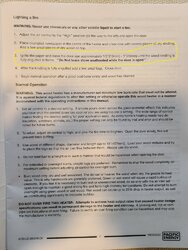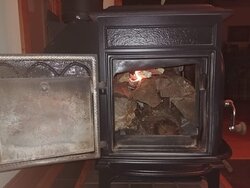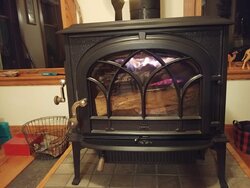Anybody else have to leave your door open a bit to get a fire going?
- Thread starter Ignem
- Start date
-
Active since 1995, Hearth.com is THE place on the internet for free information and advice about wood stoves, pellet stoves and other energy saving equipment.
We strive to provide opinions, articles, discussions and history related to Hearth Products and in a more general sense, energy issues.
We promote the EFFICIENT, RESPONSIBLE, CLEAN and SAFE use of all fuels, whether renewable or fossil.
You are using an out of date browser. It may not display this or other websites correctly.
You should upgrade or use an alternative browser.
You should upgrade or use an alternative browser.
Sawset
Minister of Fire
Top down solves a lot of issues with a smooth quick and successful startup.never done top down starts; i'll look into it. i'm not advising anyone use the ash door, just that i do and haven't had any issues.
On a re-burn tube type, there is a supply of air coming through those tubes most of the time, we just don't see it unless there are also flames. Starting right up top takes advantage of that and kicks off aggressive heat right away. It doesn't rely on getting everything going at once, in a relatively oxygen poor area down below. Opening up doors etc helps with the latter, but isn't nearly as needed with top down. It helps to have upper door(s) open briefly, to get at least something going, but the re-burn tubes, with dry wood, should be able to take over quickly. Wet wood - that's a whole nother story. A door adjar for an hour may be needed to keep wet wood from smothering, or until the gallons of water are boiled off.
not to beat this to death, but going back to the OP and replies regarding cracking the door to increase airflow, I just looked at my Seneca manual, and it states, in bold letters:
WARNING: OPERATE YOUR SENECA ONLY WITH ANY DOORS FULLY OPEN OR FULLY CLOSED. THE ONLY DOOR THAT MAY BE LEFT FULLY OPEN IS THE FRONT DOOR, AND ONLY WHEN THE OPTIONAL SPARK SCREEN IS IN PLACE.
So, according to the users manual, I would be forbidden from attempting what the OP is doing, and i believe others have OK'D? of course, perhaps other stove manuals explicitly state that cracking upper doors is acceptable. however, in reality, over the years, i have certainly utilized the cracked door method like many others.
WARNING: OPERATE YOUR SENECA ONLY WITH ANY DOORS FULLY OPEN OR FULLY CLOSED. THE ONLY DOOR THAT MAY BE LEFT FULLY OPEN IS THE FRONT DOOR, AND ONLY WHEN THE OPTIONAL SPARK SCREEN IS IN PLACE.
So, according to the users manual, I would be forbidden from attempting what the OP is doing, and i believe others have OK'D? of course, perhaps other stove manuals explicitly state that cracking upper doors is acceptable. however, in reality, over the years, i have certainly utilized the cracked door method like many others.
I crack the door sometimes at this time of year if things don't look lively enough, but once outside temperatures are closer to freezing, I get more than enough draft with the door closed. As others have said, it's far too easy to get distracted, I always set a timer whenever I have the door cracked or air control fully open. That NASA roar is cool and everything, but no thanks.
TE
TE
Sawset
Minister of Fire
I wonder if startup and long term operating are two different things. If I left a door cracked open here for very long there would be a noticeable inferno going. Closed, not so, and wide open, probably not so.not to beat this to death, but going back to the OP and replies regarding cracking the door to increase airflow, I just looked at my Seneca manual, and it states, in bold letters:
WARNING: OPERATE YOUR SENECA ONLY WITH ANY DOORS FULLY OPEN OR FULLY CLOSED. THE ONLY DOOR THAT MAY BE LEFT FULLY OPEN IS THE FRONT DOOR, AND ONLY WHEN THE OPTIONAL SPARK SCREEN IS IN PLACE.
So, according to the users manual, I would be forbidden from attempting what the OP is doing, and i believe others have OK'D? of course, perhaps other stove manuals explicitly state that cracking upper doors is acceptable. however, in reality, over the years, i have certainly utilized the cracked door method like many others.
i don't have re-burn tubes!Top down solves a lot of issues with a smooth quick and successful startup.
On a re-burn tube type, there is a supply of air coming through those tubes most of the time, we just don't see it unless there are also flames. Starting right up top takes advantage of that and kicks off aggressive heat right away. It doesn't rely on getting everything going at once, in a relatively oxygen poor area down below. Opening up doors etc helps with the latter, but isn't nearly as needed with top down. It helps to have upper door(s) open briefly, to get at least something going, but the re-burn tubes, with dry wood, should be able to take over quickly. Wet wood - that's a whole nother story. A door adjar for an hour may be needed to keep wet wood from smothering, or until the gallons of water are boiled off.
distraction is the key word here. how many of you are guilty of at least glancing at your phone device while driving? talk about dangerous distraction. if operating equipment that an cause harm, DO NOT GET DISTRACTED!I crack the door sometimes at this time of year if things don't look lively enough, but once outside temperatures are closer to freezing, I get more than enough draft with the door closed. As others have said, it's far too easy to get distracted, I always set a timer whenever I have the door cracked or air control fully open. That NASA roar is cool and everything, but no thanks.
TE
Mech e
Feeling the Heat
I think the key word here is "FULLY" (not sure your first sentence was copied correctly, does not quite make sense). Obviously, fully open doors is referring to the danger of sparks or logs coming out of the stove. Cracking your door to start it would not be in conflict with the manual statement above.not to beat this to death, but going back to the OP and replies regarding cracking the door to increase airflow, I just looked at my Seneca manual, and it states, in bold letters:
WARNING: OPERATE YOUR SENECA ONLY WITH ANY DOORS FULLY OPEN OR FULLY CLOSED. THE ONLY DOOR THAT MAY BE LEFT FULLY OPEN IS THE FRONT DOOR, AND ONLY WHEN THE OPTIONAL SPARK SCREEN IS IN PLACE.
So, according to the users manual, I would be forbidden from attempting what the OP is doing, and i believe others have OK'D? of course, perhaps other stove manuals explicitly state that cracking upper doors is acceptable. however, in reality, over the years, i have certainly utilized the cracked door method like many others.
As a side note, I have been in the product development business for almost forty years now. The manuals are written to give you information on how to operate the product safely and get the best performance and longevity from the device. This information comes from the engineers that developed the product. You can operate any product outside of the parameters it was designed for, but you run the risk of damaging the device and/or jeopardizing your personal safety.
Give top-down starting a try. It works fine on cat stoves too. When you load the stove leave a valley in the middle in which to put balls of newspaper or fire-starter with kindling criss-crossed on top.
is top down really that much better than bottom up, and do any stove manuals mention it (i assume they would if it is superior)?Give top-down starting a try. It works fine on cat stoves too. When you load the stove leave a valley in the middle in which to put balls of newspaper or fire-starter with kindling criss-crossed on top.
Top-down lighting creates less smoke at startup. It gets the flue hot quicker and seems to encourage secondary combustion quicker in our stove too. Yes, some stove manuals encourage this. So does Woodheat.org.
that warning can be open to some interpretation. i read it as having a gray area allowing partially opening a door. if so, the manual should mention it (i'm just reading my manual, other stove manuals may actually allow it. maybe others can chime in on that).I think the key word here is "FULLY" (not sure your first sentence was copied correctly, does not quite make sense). Obviously, fully open doors is referring to the danger of sparks or logs coming out of the stove. Cracking your door to start it would not be in conflict with the manual statement above.
As a side note, I have been in the product development business for almost forty years now. The manuals are written to give you information on how to operate the product safely and get the best performance and longevity from the device. This information comes from the engineers that developed the product. You can operate any product outside of the parameters it was designed for, but you run the risk of damaging the device and/or jeopardizing your personal safety.
i totally agree about the purpose of the manual for the general population; however, when a product enters the real world, users often find new methods and uses for products. and a lot of products can regularly stretched beyond their stated parameters. that can often lead to new developments and innovations.
Sawset
Minister of Fire
thebaron23
Member
This is what the manual for my T5 states. They recommend leaving the door open a crack during starting. See Attachment
Also, FWIW the Canadian Federal Government reccomends top down lighting as one of their 3 lighting methods in their wood burning manual.
"The advantages of the top-down fire building method are minimal start-up smoke, no chance that the fire will collapse and smother itself, and no need to open the loading door to add larger pieces once the kindling fire is established."

Also, FWIW the Canadian Federal Government reccomends top down lighting as one of their 3 lighting methods in their wood burning manual.
"The advantages of the top-down fire building method are minimal start-up smoke, no chance that the fire will collapse and smother itself, and no need to open the loading door to add larger pieces once the kindling fire is established."

thebaron23
Member
interesting, esp. the collapse and smother part. and lets not talk about the ash door anymore!
Here's the link to the Canadian Feds manual. It's quite comprehensive and there's a lot of material to learn.
Top down, or variations on it are the fastest, cleanest and most efficient way to get a modern woodstove up to clean burning temperature. We've been accustomed to bottom-up methods from millennia of open fires, but that's just not the best for a stove. I personally can't get a "pure" top down method to work, but I place large logs on the bottom, paper/firestarter on top of those, and kindling/very small splits on top of that. The kindling flares up, creates great updraft, heats the secondary tubes and there's more than enough embers to light the logs below. If I'm not cruising in less than fifteen minutes, I've done something very wrong. Typically I then drop another split into the gap where the paper and kindling was. This is usually so fast that I have secondary combustion long before the stovetop reaches 400F.is top down really that much better than bottom up, and do any stove manuals mention it (i assume they would if it is superior)?
In shoulder season, when I don't need a large load, I use two splits with a 6inch gap between them, I place paper in that gap and lay kindling across the splits. Sometimes, for fun, I place another split on top and get huge satisfaction when the kindling collapses at just the right time, dropping the top split perfectly into the gap between the lower two!
Bottom up methods by contrast create lots of smoke, are far slower to reach clean burning temperature, and by that time, so much of the load is burning intensely that it's hard to control well.
TE
Sawset
Minister of Fire
If I'm not cruising in less than fifteen minutes, I've done something very wrong.
Attachments
so, are you doing both methods?! bottom up for kindling, top down for larger?Top down, or variations on it are the fastest, cleanest and most efficient way to get a modern woodstove up to clean burning temperature. We've been accustomed to bottom-up methods from millennia of open fires, but that's just not the best for a stove. I personally can't get a "pure" top down method to work, but I place large logs on the bottom, paper/firestarter on top of those, and kindling/very small splits on top of that. The kindling flares up, creates great updraft, heats the secondary tubes and there's more than enough embers to light the logs below. If I'm not cruising in less than fifteen minutes, I've done something very wrong. Typically I then drop another split into the gap where the paper and kindling was. This is usually so fast that I have secondary combustion long before the stovetop reaches 400F.
In shoulder season, when I don't need a large load, I use two splits with a 6inch gap between them, I place paper in that gap and lay kindling across the splits. Sometimes, for fun, I place another split on top and get huge satisfaction when the kindling collapses at just the right time, dropping the top split perfectly into the gap between the lower two!
Bottom up methods by contrast create lots of smoke, are far slower to reach clean burning temperature, and by that time, so much of the load is burning intensely that it's hard to control well.
TE
Drolet also suggests top-down in their manual in addition to conventional starting. This is the video from WoodHeat.org.This is what the manual for my T5 states. They recommend leaving the door open a crack during starting. See Attachment
Also, FWIW the Canadian Federal Government reccomends top down lighting as one of their 3 lighting methods in their wood burning manual.
"The advantages of the top-down fire building method are minimal start-up smoke, no chance that the fire will collapse and smother itself, and no need to open the loading door to add larger pieces once the kindling fire is established."
I've been building top-down fires for so long now since I first learned about them here back in 2008 so that now I forget it is "abnormal" and get funny looks from folks when I start a fire that way while camping . . . most think I am nuts until they see how well it works.
thebaron23
Member
Drolet also suggests top-down in their manual in addition to conventional starting. This is the video from WoodHeat.org.
Most importantly is that this video describes exactly how we converse with eachother in Canada. We often have our friends over solely to explain to them how a wood stove works in the most condescending manner possible

Similar threads
- Replies
- 13
- Views
- 447
- Replies
- 4
- Views
- 452
- Replies
- 13
- Views
- 2K
- Replies
- 1
- Views
- 321



